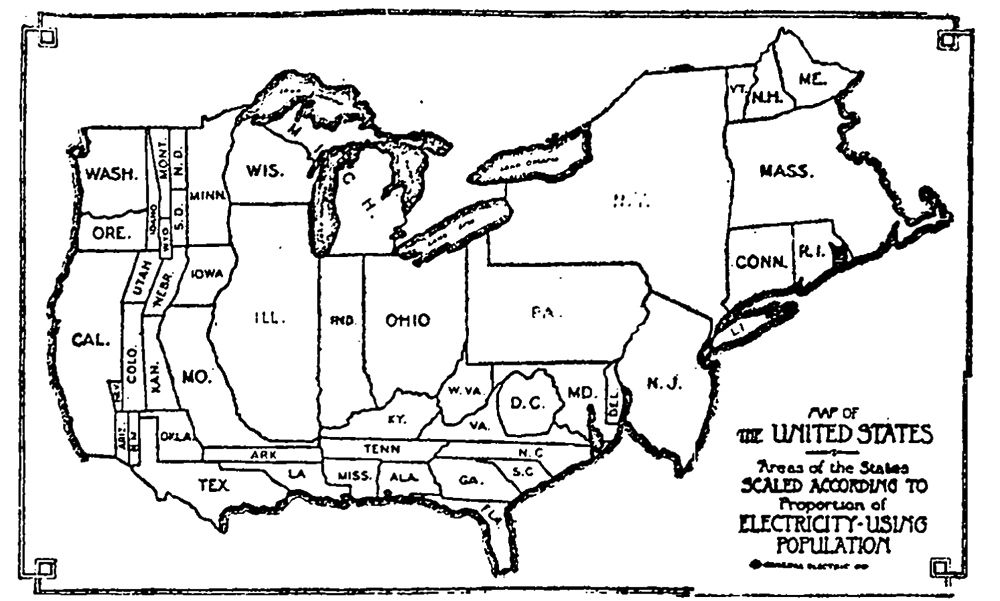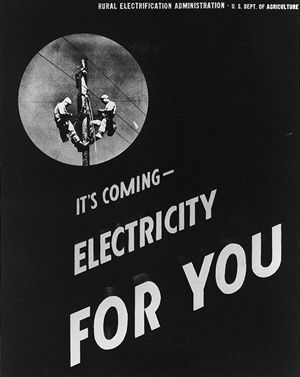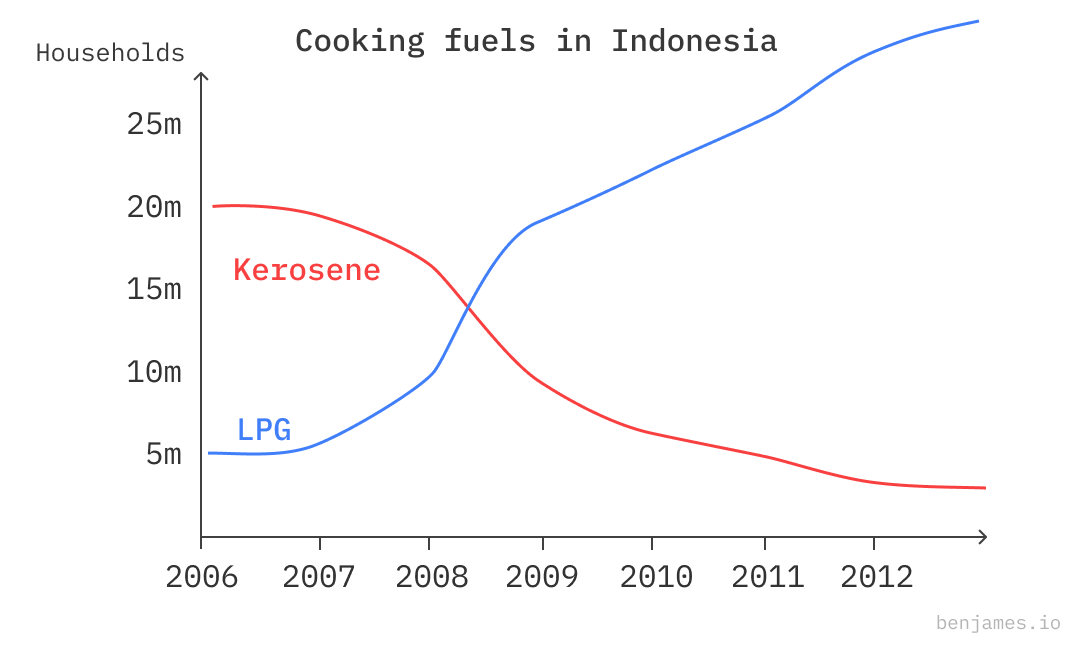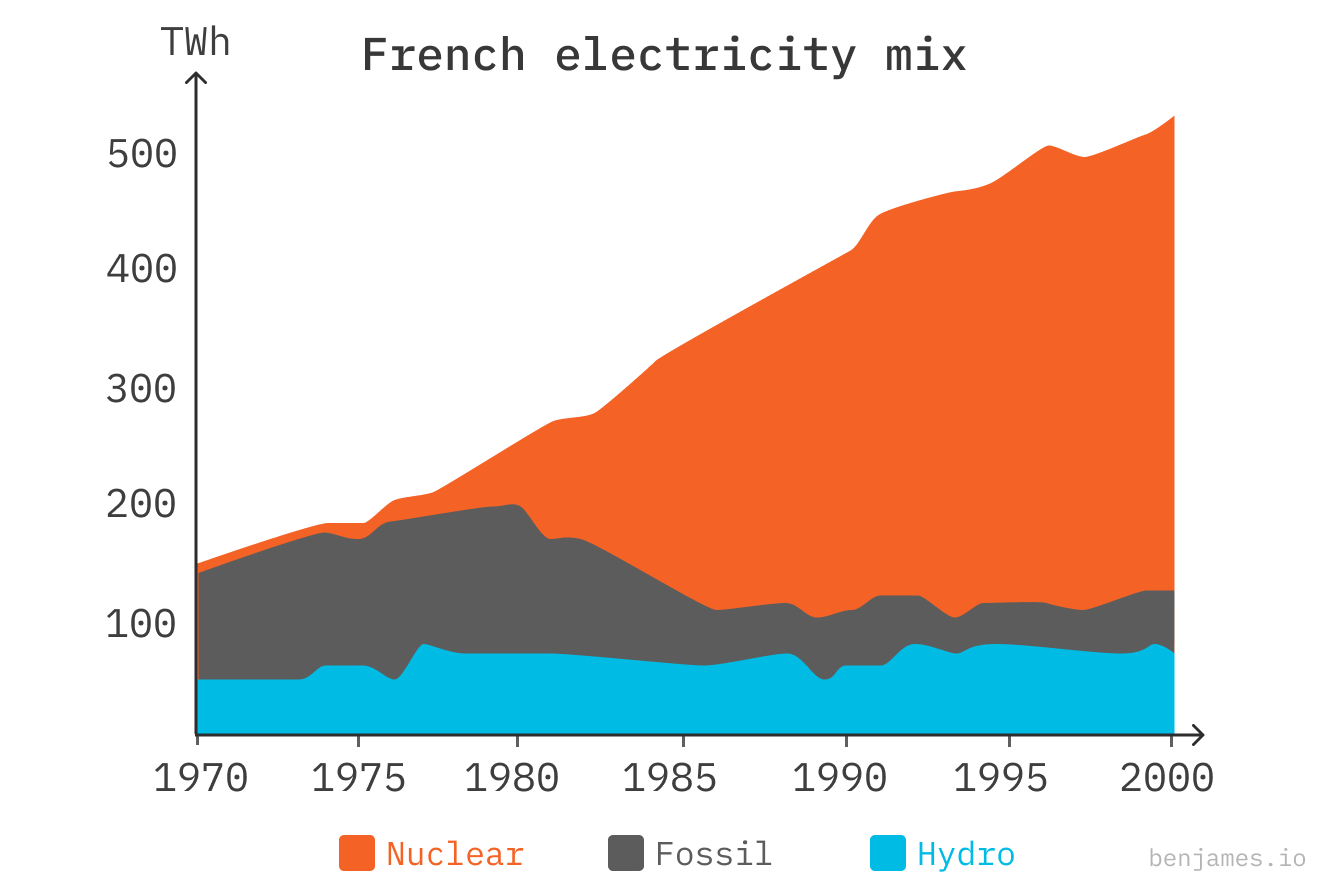Actually, we can deploy energy infrastructure very quickly.
We are told that energy transitions are always slow. But this is not supported by history.
When a nation decisively commits to building energy infrastructure, it can build fast.
We perceive that “energy can’t change quickly” because of recency bias. Most people in The West today have not experienced a major energy transition in their lifetimes. We think it's impossible to build new energy infrastructure quickly, because we haven’t recently.
People are particularly concerned about domestic energy transitions - how fast can you deploy things that touch households? Electrification relies on breakneck deployment of heat pumps, electric vehicle charging, and the associated upgrades to the local distribution grid (which are significant). Luckily, there is a rich history of domestic energy transitions going very rapidly.
Here are four examples. We’ll pick out some common features after.
UK, 1960s. Town gas to natural gas
Up to 1967, the only gas used in Britain was “manufactured” from coal. People called it town gas, because each city had a local gas works, which heated up coal to produce gas. It was dirty, expensive, and dangerous.
Then, Britain discovered 'natural gas' in the North Sea. Natural gas was much safer and cleaner than coal gas - but it would require new burners in gas appliances (heaters, cookers and lamps). Making the change would be disruptive for all gas users in Britain, but the government of the day fully committed to it.
In just ten years, 14 million homes were converted, and 40 million appliances were replaced. Each home cost £1,700 (inflation adjusted) to convert on average.
Thirteen dedicated training schools were set up across the country, and a national workforce was trained up to replace appliances and infrastructure. It was hailed as “the greatest peacetime operation in this nation’s history” by the chairman of the British Gas Corporation (then state-owned).
They ran showrooms in every town and city, which dealt with accounts and service queries as well as selling cookers, heaters and smaller appliances. They offered rental and hire purchase terms to those who could not buy outright, making new equipment available to a wide range of householders for the first time. - Resilience.org & Rapid Transition Alliance

Many people protested moving from coal to new-fangled gas. Their arguments sound very similar to those who resist electrification today.
In an entertaining transcription of a parlimentary debate from 1968, a young Margaret Thatcher vehemently argues against natural gas, resists the writing off of coal gasification plants, and telling of the horror of workers coming to upgrade town gas appliances.
We looked at the gas fires in the bedrooms and his face grew graver and graver. 'I'm afraid', he advised me, rather in the manner of a doctor diagnosing smallpox, 'that we shall have to take them away’
US, 1930s. Rural Electrification Act
In 1936, only 10% of US rural homes had access to electricity (the national average was 65%).
Here’s a map with states scaled to the proportion of their population with access to centrally-produced electricity

In 1936, FDR signed the ambitious Rural Electrification Act (REA), to connect all of America to the grid. It was extraordinarily successful. The proportion of rural homes with electricity jumped from 10% to 90% in just 14 years.
New transmission lines were planned, built and owned by local cooperatives, formed of rural residents. The REA encouraged these cooperatives to form by providing low interest government-backed loans. Cooperatives were also provided with technical assistance, qualified engineers, and standardised equipment. The REA standardised poles, power transformers, and electrical wires. Before the programme started, transmission lines cost up to $2,000 per mile. By 1939 it was $825 per mile.

Indonesia, 2007. Cooking fuels
In 2007, Indonesia launched one of the most ambitious cooking fuel conversion programs in history. At the time, kerosene was the primary fuel for domestic cooking, and state subsidies for kerosene imports cost $5 billion annually. LPG (Liquefied Petroleum Gas) was chosen as a cheaper alternative, that also emits roughly half the CO2 of kerosene when cooking.
In 2007, a nationwide conversion programme was launched, and within five years, almost all kerosene-burning households had converted to LPG. Many users of wood-for-cooking also switched.

The program distributed 57 million LPG starter kits. Each contained a 3kg LPG cylinder, stove, and regulator. The rollout was intense; at its peak, 180,000 packages were being distributed daily.
By 2015, the government had saved an estimated $11.8 billion in reduced subsidies, indoor air quality had dramatically improved, and millions of tonnes of CO2 were avoided. All in all, the conversion program reduced domestic kerosene use by 92% in less than ten years.
Nonetheless, LPG remains an expensive and imported fossil fuel. Indonesia is now drawing up plans for a large-scale deployment of electrified rice cookers and induction stoves.
France, 1970s. Nuclear power
The prominence of nuclear power in France is well known. But the speed that they deployed their nuclear fleet is often missed.
When the 1973 oil crisis hit, France realised that it was entirely dependent on imported oil. This 1974 government ad is extremely entertaining. It concludes "In France, we do not have oil, but we have ideas."
In 1974 France unveiled the Messmer Plan - which called for the fastest buildout of nuclear power in history. It worked astonishingly well.
- In 1974, France had just 8 operating nuclear reactors, and only one was French-designed.
- By 1990, France had built 56 new reactors.
- Between 1980-85, France was connecting a new reactor to the grid every 2-3 months.
- Between 1970 and 1990, France took nuclear power generation from 4% of electricity generation to over 70%.

Their playbook was very simple. Firstly, they standardised heavily and built the same reactor design repeatedly. Secondly, they streamlined regulation to make rapid construction possible. Finally, clear government support of the project made it easy for EDF (the company building the reactors) to raise cheap capital, which was crucial for the high upfront costs of large nuclear.
(These three points remain all that is necessary to foster a thriving nuclear industry today.)
The list goes on
- Between 1970 and 1990, oil use for heating in Sweden plummeted from 75% to 25%. It was replaced by district heating, heat pumps, and resistive heating.
- Between 1975 and 1985, Brazil went from making almost no ethanol, to replacing about 60% of gasoline consumption.
- Between 1950 and 1970, the UK quadrupled electricity supply from 50 TWh to 220 TWh.
- Between 2005 and 2010, the Cuban energy revolution eliminated blackouts, by distributing millions of efficient appliances within months, and installing decentralised electricity generation. They saved an estimated $1bn a year in oil imports.
- Between 2018 and right now, Vietnam has gone from 0 GW of installed solar to 10 GW.
Exceptions or the rule?
It's conspicuous that these examples come from (1) rich countries pre-1990, or (2) poorer countries that were getting richer.
It’s also true that most energy transitions are slower than these, so you might reasonably ask if these examples are the exception rather than the rule. In my opinion that’s the wrong question to ask, because these examples became exceptions based on how hard they tried. It is not mere luck whether your infrastructure project succeeds; you change the outcome by how you set it up.
I am not saying that all energy transitions are fast. But I am saying that it’s possible for them to be fast, if we create the right circumstances. So what are those circumstances?
Pattern-matching successful projects
Some clear patterns emerge from the examples above. In all cases:
- The technology was well established. Technical risk was not a concern.
- Policy was extraordinarily strong. Even though the state did not usually install the new infrastructure, they created a cast iron framework of incentives, loans, and support.
- A huge workforce was needed, and training up tens of thousands of people was a core requirement (and economic benefit)
- In most cases, the state did not own the final infrastructure. Local communities did.
- Deployed technology was ruthlessly standardised.
- National priorities were placed above NIMBYism, but locals often benefited from the technology too.
The West’s fundamental disadvantage in the energy transition is that it has forgotten what bold industrial development looks like, because it happened so long ago. The good news is that the necessary remedies, above, are very simple.
There’s one other thing. A lot of historical energy infrastructure was large, centralised projects. And we’ll certainly need more of them. But the core technologies of electrification are decentralised. We will not execute large projects in series, we will roll out millions of EVs, heat pumps, solar panels and batteries in parallel. We’ve already started.

If all you extrapolate is the past two decades of energy deployment in rich countries, the energy transition looks pretty tough. But electrification’s core technologies (batteries/EVs, solar, and wind) are just starting to hit the right price levels for mass deployment.
The technology is arriving. The question is: will we be bold enough to deploy it?
-
Follow me on Twitter/X, and read my other writings: